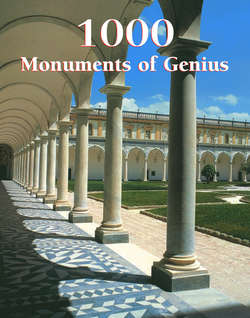Читать книгу 1000 Monuments of Genius - Christopher E.M. Pearson - Страница 10
На сайте Литреса книга снята с продажи.
Asia and Oceania
The 19th and 20th Centuries
ОглавлениеThe linked rise of imperialism and industrialism radically altered the architectures of Asia and Australasia, largely supplanting native traditions with Western styles and techniques. In India the British Raj of 1858–1947 saw the importation of European traditions for churches, railway stations and the offices and homes of colonial administrators in Madras, Calcutta and elsewhere. Towards the end of this period we need only look at the monumental governmental complex at New Delhi, designed by Sir Herbert Baker and Sir Edwin Lutyens in a Classical style inflected by Mughal traditions, to see the imperial machine in operation. A new period of Indian architecture opens up with independence and nationhood for India, Pakistan and Bangladesh, one that has witnessed attempts to come to terms both with the technical and aesthetic innovations of Western modernism as well as such pressing social realities as overpopulation and poverty. Even after independence, however, India has tended to look to the West for inspiration, and in the 1950s and 1960s it was the French-Swiss architect Le Corbusier who was chosen to design the new capital city of Chandigarh in the Punjab, and the American Louis Kahn who took charge of the government buildings of Dhaka, Bangladesh. In recent years, Indian architects such as Charles Correa and Balkrishna Doshi, though clearly influenced by their Western mentors, have worked to generate an appropriately hybrid modernism for their native country, one that can reflect both new approaches and traditional regional concerns.
With the exception of a brief incursion of the Italian Baroque through Jesuit influence in the early 18th century, China remained closed to foreign architectural trends until the early 20th century. Contrary to what happened in Japan, a subsequent period of hybrid Western-Asian building later gave way to an implicit adoption of modernist principles, and in recent years the opening of Chinese markets to the West has led to an extraordinary boom in highrise architecture in Beijing and other economic zones. Japan, after its opening to the West in the mid-19th century, has gradually assumed its position in the forefront of contemporary architecture. Foremost among 20th century Japanese architects was Kenzo Tange, who began his career by designing the Peace Centre in Hiroshima. Tange’s primary influence – as was that of his teacher Kunio Maekawa (who worked in the master’s Paris atelier) and many other later Japanese architects, including Tadao Ando – is that of Le Corbusier. Following Le Corbusier’s Brutalist deployment of raw concrete in bold and striking forms, Japan continues to set the world benchmark of skilful and elegant concrete construction. Towards the end of the 20th century, the increasingly futuristic approach of some Japanese architects led to a kind of modernist ‘Baroque’ that has produced formally complex and expressive results.
A typically forward-looking monument of the present era in Asian architecture is represented by C. Y. Lee and Partners’ Taipei 101 tower in Taiwan (1999–2004), a centre for international finance. Its 101 stories embody a fusion of Western technology and modernist aesthetics with Asian economic might and traditional iconography. Innovative engineering – including a huge steel pendulum suspended between the 92nd to the 88th floors as a giant tuned mass damper to offset deflection of the building in high winds – makes it an extremely stable structure, able to withstand earthquakes and typhoons. At the same time, an elaborate cosmological and numerological symbolism has been claimed for the tower, and the repeated segmentation of its envelope suggests a pagoda form.
